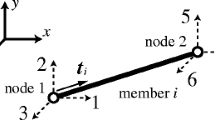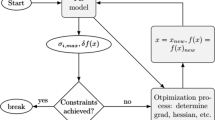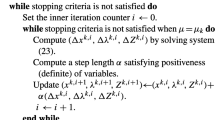Abstract
This paper presents a method for structural optimization of discrete trusses using Graphic Statics. As opposed to traditional structural optimization techniques, which are typically conducted by manipulating the geometry of the structure (the form diagram), the approach presented in this paper establishes a Graphic Statics solution to the problem, where structural optimization is conducted using design variables in the force domain (force diagram). The proposed approach presents several attractive features compared to traditional approaches. Since it is based on reciprocal graphical relationships between form geometry and forces, member stiffnesses need not be calculated. Additionally, by working on the force diagram, equilibrium of the solution is guaranteed, and no additional methods are required to enforce this condition; for example, there is no need to triangulate the structure or to add small area members. Furthermore, because only solutions that are in equilibrium are permitted, the number of design variables can be reduced. Also, subject to certain relationships, the location of the loads (or reactions) do not need to be set a priori. Through examples, it is shown that the proposed methodology can readily accommodate different tensile and compressive stresses for volume optimization problems and that, through the use of Graphic Statics, other restrictions or constraints on the member forces can easily be incorporated.











Similar content being viewed by others
References
Altair Engineering Web Page (2013) www.altair.com
Achtziger W (1997) Topology optimization of discrete structures: an introduction in view of computational and nonsmooth aspects. In: Topology optimization in structural mechanics, pp 57–100
Achtziger W, Bendsoe MP, Ben-Tal A, Zowe J (1992) Equivalent displacement based formulations for maximum strength truss topology design. IMPACT Comput Sci Eng 4(4):315–345
AISC (2010) ANSI/AISC 360-10 specification for structural steel buildings, pp 16.1-33
Baker WF, Beghini LL, Mazurek A, Carrion J, Beghini A (2013) Maxwell’s reciprocal diagrams and discrete Michell frames. Struct Multidisc Optim. doi:10.1007/s00158-013-0910-0
Beghini A, Beghini L, Carrion J, Mazurek A, Baker WF (2013) Rankine’s theorem for the design of cable structures. Struct Multidisc Optim. doi:10.1007/s00158-013-0945-2
Ben-Tal A, Bendsoe MP (1993) A new method for optimal truss topology design. SIAM J Optim 3(2):322–358
Bendsoe MP (1989) Optimal shape design as a material distribution problem. Struct Optim 1(4):193–202
Bendsoe MP, Kikuchi N (1988) Generating optimal topologies in structural design using a homogenization method. Comput Methods Appl Mech Eng 71(2):197–224
Bendsoe MP, Sigmund O (1999) Material interpolation schemes in topology optimization. Arch Appl Mech 69(9–10):635–654
Bendsoe MP, Sigmund O (2002) Topology optimization: theory, methods and applications. Springer, Berlin
Bow R (1873) Economics of construction in relation to framed structures. ICE Publishing, London
Christensen P, Klarbring A (2008) An introduction to structural optimization. Springer, New York. ISBN 978-1402086656
Cremona L (1872) Le figure reciproche nella grafica statica. Tipografia Giuseppe Bernardoni, Milano
Dorn W, Gomory R, Greenberg M (1964) Automatic design of optimal structures. J Mech 3:25–52
Fivet C, Zastavni D (2012) Robert Maillart’s key methods from the Salginatobel bridge design process (1928). J IASS 53(1):39–47
Fleron P (1964) The minimum weight of trusses. Bygningsstatiske Meddelelser 35:81–96
Hansen S, Vanderplaats G (1988) An approximation method for configuration optimization of trusses. AIAA J 28(1):161–168
Hemp WS (1973) Optimum structures. Clarendon Press, Oxford
Hemp W (1974) Michell framework for uniform load between fixed supports. Eng Optim 1(1):61–69
Krog L, Tucker A, Kemp M, Boyd R (2004) Topology optimization of aircraft wing box ribs. In: 10th AIAA/ISSMO multidisciplinary analysis and optimization conference, pp 2004–4481
Maxwell JC (1864) On reciprocal figures and diagrams of forces. Phil Mag 26:250–261
Maxwell JC (1870) On reciprocal figures, frames, and diagrams of forces. Edinb Roy Soc Proc 7:160–208
Mazurek A, Baker WF, Tort C (2011) Geometrical aspects of optimum truss like structures. Struct Multidisc Optim 43(2):231–242
McConnel RE (1974) Least weight frameworks for loads across a span. J Eng Mech Div 100(5):885–891
Michell AGM (1904) The limits of economy of material in frame-structures. Phil Mag 8(47):589–597
Oberndorfer JM, Achtziger W, Hörnlein H (1996) Two approaches for truss topology optimization: a comparison for practical use. Struct Multidisc Optim 11(3):137–144
Pichugin AV, Tyas A, Gilbert M (2012) On the optimality of Hemps arch with vertical hangers. Struct Multidiscipl Optim 46(1):17–25. doi:10.1007/s00158-012-0769-5
Prager W (1970) Optimization of structural design. J Optim Theory Appl 6(I):1–21
Prager W (1978) Optimal layout of trusses with finite numbers of joints. J Mech Phys Solids 26:241–250
Rahami H, Kaveh A, Gholipour Y (2008) Sizing, geometry and topology optimization of trusses via force method and genetic algorithm. Eng Struct 30(9):2360–2369
Rozvany GIN (1976) Optimal design of flexural systems. Pergamon Press, Oxford
Rozvany GIN (1989) Structural design via optimality criteria. Kluwer Academic Publishers Group, Dordrecht
Rozvany GIN (1996) Some shortcomings in Michell’s truss theory. Struct Multidisc Optim 12(4):244–250
Rozvany GIN, Zhou M, Birker T (1992) Generalized shape optimization without homogenization. Struct Multidisc Optim 4(3):250–252
Rozvany GIN, Bendsoe MP, Kirsch U (1995) Layout optimization of structures. Appl Mech Rev 48(2):41–119
Sigmund O (2000) Topology optimization: a tool for the tailoring of structures and materials. Philos T Roy Soc A 358(1765):211–227
Sokol T (2010) A 99 line code for discretized Michell truss optimization written in Mathematica. Struct Multidisc Optim 43(2):181–190
Stromberg LL, Beghini A, Baker WF, Paulino GH (2012) Topology optimization for braced frames: combining continuum and beam/column elements. Eng Struct 37:106–124
Sutradhar A, Paulino GH, Miller MJ, Nguyen TH (2010) Topological optimization for designing patient-specific large craniofacial segmental bone replacements. Proc Natl Acad Sci USA 107(30):13,222–13,227
Svanberg K (1987) The method of moving asymptotes—a new method for structural optimization. Int J Numer Methods Eng 24:359–373
Svanberg K (2013) Personal webpage of Krister Svanberg, Professor. http://www.math.kth.se/krille/
Talischi C, Paulino GH, Pereira A, Menezes IFM (2012a) PolyMesher: a general-purpose mesh generator for polygonal elements written in Matlab. Struct Multidisc Optim 45(3):309–328
Talischi C, Paulino GH, Pereira A, Menezes IFM (2012b) PolyTop: a Matlab implementation of a general topology optimization framework using unstructured polygonal finite element meshes. Struct Multidisc Optim 45(3):329–357
Wolfe W (1921) Graphical analysis. McGraw-Hill Book Co. Inc., New York
Zalewski W, Allen E (1998) Shaping structures: statics. Wiley, New York
Zastavni D (2008) The structural design of Maillart’s Chiasso Shed (1924): a graphic procedure. Struct Eng Int J Int Assoc Bridge Struct Eng 18(3):247–252
Zhou M, Rozvany GIN (1991) The COC algorithm, Part II: topological, geometrical and generalized shape optimization. Comput Methods Appl Mech Eng 89(1–3):309–336
Zhou M, Rozvany GIN (1993) DCOC: an optimality criteria method for large systems Part II: algorithm. Struct Multidisc Optim 6(4):250–262
Author information
Authors and Affiliations
Corresponding author
Rights and permissions
About this article
Cite this article
Beghini, L.L., Carrion, J., Beghini, A. et al. Structural optimization using graphic statics. Struct Multidisc Optim 49, 351–366 (2014). https://doi.org/10.1007/s00158-013-1002-x
Received:
Revised:
Accepted:
Published:
Issue Date:
DOI: https://doi.org/10.1007/s00158-013-1002-x




